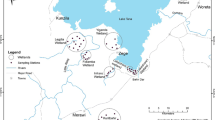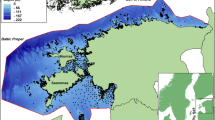Abstract
In this article a concept is described in order to predict and map the occurrence of benthic communities within and near the German Exclusive Economic Zone (EEZ) of the North Sea. The approach consists of two work steps: (1) geostatistical analysis of abiotic measurement data and (2) calculation of benthic provinces by means of Classification and Regression Trees (CART) and GIS-techniques. From bottom water measurements on salinity, temperature, silicate and nutrients as well as from punctual data on grain size ranges (0–20, 20–63, 63–2,000 μ) raster maps were calculated by use of geostatistical methods. At first the autocorrelation structure was examined and modelled with help of variogram analysis. The resulting variogram models were then used to calculate raster maps by applying ordinary kriging procedures. After intersecting these raster maps with punctual data on eight benthic communities a decision tree was derived to predict the occurrence of these communities within the study area. Since such a CART tree corresponds to a hierarchically ordered set of decision rules it was applied to the geostatistically estimated raster data to predict benthic habitats within and near the EEZ.
Similar content being viewed by others
References
Arentze, T., & Timmermans, H. (2005). An analysis of context and constraints-dependent shopping behaviour using qualitative decision principles. Urban Studies, 42(3), 435–448.
Breiman, L., Freidman, J. H., Olshen, R. A., & Stone, C. J. (1984). Classification and regression trees. Wadsworth.
Callaway, R., Alsvåg, J., De Boois, I., Cotter, J., Ford, A., Hinz, H., et al. (2002). Diversity and community structure of epibenthic invertebrates and fish in the North Sea. ICES Journal of Marine Science, 59, 1199–1214.
Chihi, H., Galli, A., Ravenne, C., Tesson, M., & De Marsily, G. (2000). Estimating the depth of stratigraphic units from marine seismic profiles using nonstationary geostatistics. Natural Resources Research, 9(1), 77–95.
Duineveld, G. C. A., Kuenitzer, A., Niermann, U., De Wilde, P. A. W. J., & Gray, J. S. (1991). The macrobenthos of the North Sea. Netherlands Journal of Sea Research, 28(1–2), 53–65.
Glémarec, M. (1973). The benthic communities of the European North Atlantic shelf. Oceanography and Marine Biology: An Annual Review, 11, 263–289.
Heip, C., & Craeymeersch, J. A. (1995). Benthic community structures in the North Sea. Helgoland Marine Research, 49, 313–328.
Huetmann, F., & Diamond, A. W. (2001). Seabird colony locations and environmental determination of seabird distribution: A spatially explicit breeding seabird model for the Northwest Atlantic. Ecological Modelling, 141(1), 261–298.
Hughes, R. M. (1997). Use of ecoregions in biological monitoring. In S. L. Loeb & A. Spacie (Eds.), Biological monitoring of aquatic systems (pp. 125–151). Boca Raton, FL.
ICES (2005). Report of the Working Group on Habitat Mapping (WGMHM). Bremerhaven, Germany: ICES, C.M. 2005/E:05, 87.
Jennings, S., Lancaster, J., Woolmer, A., & Cotter, J. (2001). Distribution, diversity and abundance of epibenthic fauna in the North Sea. Journal of the Marine Biological Association of the United Kingdom, 79, 385–399.
Jerosch, K., Pesch, R., & Schlüter, M. (2006). Spatial analysis of marine categorical information using indicator kriging applied to georeferenced video mosaics of the deep-sea Håkon Mosby Mud Volcano. Ecological Informatics, 1(4), 391–406. doi:10.1016/j.ecoinf.2006.05.003.
Jerosch, K., Schlüter, M., Pesch, R., Schröder, W., Köberle, A., & Vetter, L. (2005). MarGIS Marine Geo-Information-System for visualisation and typology of marine geodata. In Conference Proceedings EnviroInfo, (pp. 165–174).
Johnston, K., Ver Hoef, V. M., Krivoruchko, K., & Lucas, N. (2001). Using ArcGIS geostatistical analyst. Tulsa, USA: ESRI Selbstverlag.
Jones, N. S. (1950). Marine bottom communities. Biological Reviews, 25, 283–313.
Kingston, P. F., & Rachor, E. (1982). North Sea level bottom communities. ICES, C.M.1982/L:41, 20.
Krige, D. G. (1951). A statistical approach to some basic mine evaluation problems on the Witwatersrand. Journal of the Chemical and Metallurgical Society of South Africa, 52(6), 119–139.
Kröncke, I., & Bergfeld, C. (2001). Synthesis and new conception of North Sea research (SYCON), working group 10: Review of the current knowledge on North Sea benthos. Berichte ZMK, Reihe Z, 12, 138.
Kuenitzert, A., Basford, D., Craeymeersch, J. A., Dewarumez, J. M., Dorjes, J., Duineveld, G. C. A., et al. (1992). The benthic infauna of the North Sea: Species distribution and assemblages. ICES Journal of Marine Science, 49(2), 127–143.
Lawrence, R., & Labus, M. (2003). Early detection of Douglas-Fir beetle infestation with subcanopy resolution hyperspectral imagery. Western Journal of Applied Forestry, 18(3), 202–206.
Lourie, S. A., & Vincent, A. C. J. (2004). Using biogeography to help set priorities in marine conservation. Conservation Biology, 18(4), 1004–1020.
Matheron, G. (1965). Les variables régionalisées et leur estimation. Paris: Masson.
Matheron, G. (1971). The theory of regionalized variables and its application. Fontainebleau.
Norcross, B. L., Blanchard, A., & Holladay, B. A. (1999). Comparison of models for defining nearshore flatfish nursery areas in Alaskan waters. Fishery and Oceanography, 8(1), 50–67.
OSPAR Commission (2000). Quality status report 2000: Region II – Greater North Sea. London, U.K.: OSPAR Commission, 136 + xiii.
Pehlke, H. (2005). Prädiktive Habitatkartierung für die Ausschließliche Wirtschaftszone (AWZ) der Nordsee, Diplomarbeit, Universität Vechta, Institut für Umweltwissenschaften.
Petersen, C. G. J. (1914). Valuation of the sea II. The animal communities on the sea-bottom and their importance for marine zoogeography. Report of the Danish Biological Station, 21, 1–44.
Petitgas, P. (1997). Sole egg distribution in space and time characterised by a geostatistical model and its estimation variance. ICES Journal of Marine Science, J. Conseil., International Council for the Exploration of the Sea, (Bd. 54, pp. 213–225). London: Academic.
Poon, K. F., Wong, R. W. H., Lam, M. H. W., Yeung, H. Y., & Chiu, T. K. T. (2000). Geostatistical modelling of the spatial distribution of sewage pollution in coastal sediments. Water Research, 34(1), 99–108.
Rachor, E., & Nehmer, P. (2003). Erfassung und Bewertung ökologisch wertvoller Lebensräume in der Nordsee, Abschlußbericht für das FuE-Vorhaben FKZ 899 85 310 (Bundesamt für Naturschutz). Bremerhaven: Alfred-Wegener-Institut für Polar- und Meeresforschung.
Reiniger, C. (1997). Bioregional planning and ecosystem protection. In G. F. Thompson & F. Steiner (Eds.), Ecological design and planning (pp. 185–200). New York.
Remane, A. (1940). Einführung in die zoologische Ökologie der Nord- und Ostsee. In Tierwelt der Nord- und Ostsee Ia (p. 238). Leipzig, Germany: Grimpe and Wagler.
Rosenfeld, B., & Lewis, C. H. (2005). Assessing violence risk in stalking cases: A regression tree. Law and Human Behavior, 29(3), 343–357.
Ryan, W. F. (1995). Forecasting severe ozone episodes in the Baltimore metropolitan area. Atmospheric Environment, 29(17), 2387–2398.
Salzwedel, H., Rachor, E., & Gerdes, D. (1985). Benthic macrofauna communities in the German Bight. Institut für Meeresforschung in Bremerhaven, 20, 199–267.
Schlüter, M., Rutgers van der Loeff, M. M., Holby, O., & Kuhn, G. (1998). Silica cycle in surface sediments of the South Atlantic. Deep-Sea Research I, 45, 1085–1109.
Schröder, W., & Schmidt, G. (2003). Medienübergreifende Umweltbeobachtung in Baden-Württemberg. Ergebnisse eines Modellprojekts. In Landesanstalt für Umweltschutz (Eds.), Medienübergreifende Umweltbeobachtung (pp. 39–60). Karlsruhe: Stand und Perspektiven.
Steinberg, D., & Colla, P. (1995). CART: Tree-structured non-parametric data analysis. San Diego, CA: Salford Systems.
Stelzenmüller, V. (2005). Möglichkeiten und Grenzen geostatistischer Verfahren in den Fischereiwissenschaften: Analyse räumlicher und zeitlicher Variabilität von Fischpopulationen (p. 128). Doctoral thesis, Carl von Ossietzky Universität Oldenburg.
Swan, G. E., Javitz, H. S., Jack, L. M., Curry, S. J., & McAfee, T. (2004). Heterogeneity in 12-month outcome among female and male smokers. Addiction, 99(2), 237–250.
Thorson, G. E. (1957). Bottom communities (sublittoral or shallow shelf). Geol. Soc. Am. Mem., 67(1), 461–534.
Thuiller, W. (2003). BIOMOD – Optimizing predictions of species distributions and projecting potential future shifts under global change. Global Change Biology, 9(10), 1353–1362.
Walmsley, J. L., Barthelmie, R. J., & Burrows, W. R. (2001). The statistical prediction of offshore winds from land-based data for wind-energy applications. Bound-Lay Meteorology, 101(3), 409–433.
Webster, R., & Oliver, M. (2000). Geostatistics for environmental scientists (p. 272). Wiley.
Yisehac, Y., & Webb, P. (1999). Classification and regression trees, cart: A user manual for identifying indicators of vulnerability to famine and chronic food insecurity. International Food Policy Research Institute, Microcomputers in Policy Research, 3.
Author information
Authors and Affiliations
Corresponding author
Rights and permissions
About this article
Cite this article
Pesch, R., Pehlke, H., Jerosch, K. et al. Using decision trees to predict benthic communities within and near the German Exclusive Economic Zone (EEZ) of the North Sea. Environ Monit Assess 136, 313–325 (2008). https://doi.org/10.1007/s10661-007-9687-1
Received:
Accepted:
Published:
Issue Date:
DOI: https://doi.org/10.1007/s10661-007-9687-1




